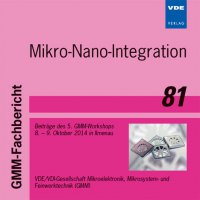Integrated Opto-Chemical Sensor System based on Group III-nitride Nanowires
Konferenz: Mikro-Nano-Integration - Beiträge des 5. GMM-Workshops
08.10.2014 - 09.10.2014 in Ilmenau, Deutschland
Tagungsband: Mikro-Nano-Integration
Seiten: 6Sprache: EnglischTyp: PDF
Persönliche VDE-Mitglieder erhalten auf diesen Artikel 10% Rabatt
Autoren:
Kleindienst, R.; Krüger, M.; Grewe, A.; Sinzinger, S. (Technische Universität Ilmenau, Institut für Mikro- und Nanotechnologien (IMN MacroNano®), Fachgebiet Technische Optik, POB 100565, 98684 Ilmenau, Germany)
Holc, K.; Schätzle, J.; Steffen, A.; Cimalla, V.; Schwarz, U. T. (Fraunhofer Institute for Applied Solid State Physics IAF, Freiburg, Germany)
Schwarz, U. T. (Albert-Ludwigs-Universität Freiburg, Institut für Optoelektronik, Freiburg, Germany)
Becker, P.; Hille, P.; Schörmann, J.; Teubert, J.; Eickhoff, M. (Justus-Liebig-Universität Gießen, I. Physikalisches Institut, Gießen, Germany)
Inhalt:
Intense research in the field of functional nanowire structures during the last years demonstrated unique advantages for reliable and sensitive gas detection with optical readout. Because of the chemical sensitivity of their photoluminescence signal, group III-nitride nanowire heterostructures can be used to monitor the concentration of environmental gases at low temperatures or even at room temperature. In the first part of this contribution we present the optimization of the nanostructure growth with respect to the photoluminescence emission intensity, response to oxidizing gases, and corresponding response times. However, to meet the demands of industrial and commercial applications in terms of robustness, reliability, and economic aspects, the gas sensitive structures need to be integrated with the micro-scale opto-electronic excitation and detection periphery within a miniaturized sensor system. The realization of this integrated opto-chemical sensor system is covered by the second part of this paper. After introducing the concept and optical de-sign the applied fabrication technique is briefly presented. The applied approaches are evaluated with investigations of the optical performance of subsystems and profilometric characterizations. The overall detection functionality of the integrated sensor system is discussed.


